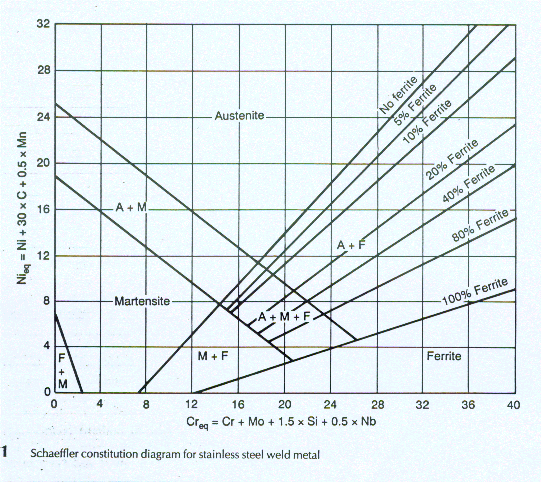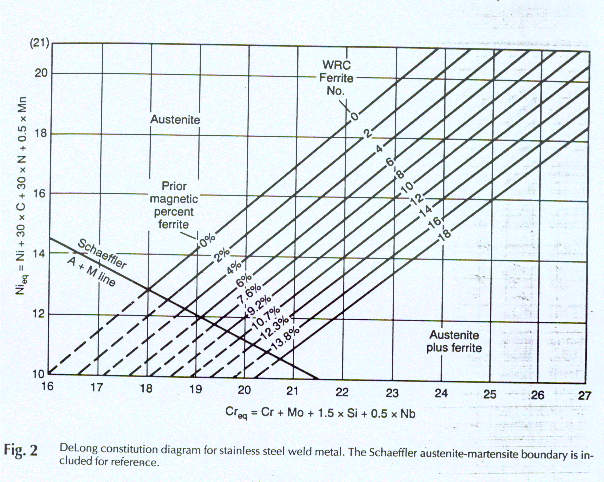Schaeffler and Delong Diagrams for Predicting Ferrite Levels
Ferrite is important in avoiding hot cracking in during cooling from welding of austenitic stainless steel. 'Constitution diagrams' are used to predict ferrite level from the composition by comparing the effects of austenite and ferrite stabilising elements. The Schaeffler and Delong diagrams are the original methods of predicting the phase balance in austenitic stainless steel weld.
Nickel and chromium equivalents
A ' nickel equivalent' is calculated for the austenite stabilising elements and a 'chromium equivalent' ferrite stabilising elements. These are used as the axes for the diagrams, which show the compositional equivalent areas where the phases austenite, ferrite, martensite (and mixtures of these) should be present. Although intended to show the phase balance of weld fillers, these diagrams can also be used to illustrate the phase balance of the 'parent' material. There are different diagrams for different alloy system.
Schaffler Diagram
The nickel and chromium equivalents use the formulae.
This gives a diagram that is useful for the austenitic steel, except those with nitrogen additions. The values for typical 304(1.4301) and 316(1.4401) composition are shown below.
| . |
Ni (equiv) |
Cr (equiv) |
| 304(1.4301) |
10.15 |
18.92 |
| 316(1.4401) |
13.15 |
19.83 |
The diagram, identifying the phase boundaries is shown below.

Delong Diagram
This refines the Schaffler diagram by taking account of the strong austenite stabilising tendency of nitrogen. The chromium equivalent is unaffected but the nickel equivalent is modified to
Ni (eq) = Ni + (30 x C) + (0.5 x Mn) + (30 x N)
The diagram, identifying the phase boundaries is shown below. This shows the ferrite levels in bands, both as percentages, based on metallographic determinations and as a ferrite number 'FN', based on magnetic determination methods.

Related References:
1. Welding Process and Letter Designations
2. Welding Stainless Steel to other Steel
3. Welding and Post Fabrication Cleaning for Construction and Architectural Application
4. Welded Stainless Steel Pipe
5. Post weld cleaning and finishing of stainless steel
6. Avoid PWHT Post Weld Heat Treatment
7. Fume Associated With Welding Stainless Steel
8. Avoiding Distortion During Welding Stainless Steel
9. Design Strength of Welded Connections
10. Processes for Welding Stainless Steel
11. Brazing Stainless Steel
12. Soldering Stainless Steel
13. Welding Stainless Steel
14. Selection of Welding Consumables Filler
15. Selection of Welding Consumable for Welding Stainless Steel
16. Filler Metals For Welding Stainless Steel
17. Schaeffler and Delong Diagrams for Predicting Ferrite Levels
18. Welding Properties of Stainless Steel
|
